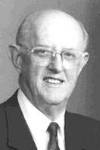Howard A. White

Howard A. White, Pepperdine University's fifth president, was an Alabama native whose family embraced education. His mother and brothers were all teachers, so young Howard grew up with a love of learning. School and religion were important foundations in his life and led him to enter David Lipscomb College during the Depression years.
Like so many others, the bank where the White family held its money went bankrupt, causing his tuition check to bounce. A dejected Howard White was prepared to leave school when Lipscomb President H. Leo Boles presented a solution to his financial dilemma and became a strong influence in his life. Boles told White to stay in school, and the college loaned him the funds to continue his education.
Tulane University-bound, White sought a pulpit job in New Orleans to augment his college activities. The elders at the Carrollton Avenue Church of Christ invited him to be their minister, on the condition that he serve in a full-time capacity. His love of education won out, however, and he got them to agree to let him attend Tulane, where he proceeded to earn undergraduate and graduate degrees in the field of history, along with Tulane's prestigious Montgomery Prize in history as the top senior in the department. His ministry at the Carrollton Avenue Church would span a dozen years-in the pulpit, on a radio program, and in weekly Bible classes.
White began teaching at David Lipscomb College in 1953. He was chairman of the history department when Norvel Young recruited him in 1958 to come to George Pepperdine College. He was a tenured professor with a $6,000 starting salary when President Young appointed him to serve on the college's administrative committee.
Unknowingly, White would be in the thick of things throughout his Pepperdine career. In 1961 he was named director of the college's graduate program, and in 1965 he became dean of graduate studies. He was dean of the undergraduate program when President Banowsky asked him to serve as executive vice president, a post he held from 1970 until Banowsky's 1978 resignation. Scholarship, leadership, and strong professional integrity were qualities that commended White to each administrative position.
In all instances save one, Howard White was tapped on the shoulder for his advancements at Pepperdine. But for one plum assignment in 1963, he raised his hand like an eager schoolboy. President Young was anxious to begin an educational program for undergraduates in Heidelberg, West Germany. White jumped at the opportunity and Young challenged him to find fifteen students for the first-year program-he recruited thirty-six. He thus became the founding director of Pepperdine's popular Year-in-Europe program, and during his presidency two decades later, White directed the expansion and renovation of Moore Haus, the Pepperdine-owned mansion that serves as home to more than fifty Seaver students each year.
His presidential portfolio is full of academic milestones. To support a greatly strengthened curriculum, thirty-three new faculty were hired at Seaver College during his term, and faculty salaries moved from the lowest level nationally to the top percent in the country. Admission standards were tightened, with a resulting 151-point rise in Scholastic Aptitude Test scores, placing Pepperdine in the selective schools category for the first time in its history.
Four urban educational centers were established in the greater Los Angeles and Orange County region to serve the growing population of graduate students in business, education, and psychology, and program requirements were tightened at all three of the graduate schools. Two doctoral programs-the first at the University-were initiated, as was an institution-wide program of computer literacy that gained national attention. A nationwide poll of college presidents conducted during his term by U.S. News & World Report magazine named Pepperdine among the top four comprehensive universities west of the Mississippi.
White also proved to be a master fund-raiser, silencing the skeptics who thought that predecessor Banowsky held the patent on such essential matters in independent higher education. Pepperdine's financial resources more than doubled during White's presidency, from $90 million to more than $208 million. The University added 200 acres to the Malibu campus and constructed major facilities at a cost in excess of $55 million, including music and theater buildings, 450 students apartments, fifty faculty and staff condominiums, Helen Field Heritage Hall, and Eddy D. Field Baseball Stadium. The majority of funds for the Charles B. Thornton Administrative Center were raised during his presidency.
White also will be remembered as the man who almost single-handedly brought the Olympic Games to Pepperdine. He recognized that Raleigh Runnels Memorial Pool would be a spectacular site for water polo competition. Further, the prospect of having a potential viewing audience of 2.5 billion for the Olympic Games was a chance that White-clearly mindful of its public relations value-would not pass up. He was a jubilant campus host throughout the ten days of water polo competition.
Howard A. White's term concluded in 1985 and he continued to stay active as president-emeritus until his health no longer allowed him to do so. He passed this life in 1991, after permanently enriching Pepperdine University and ensuring the future for its students.